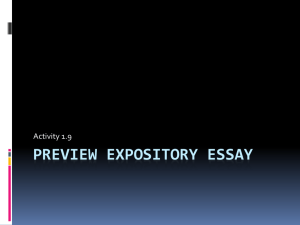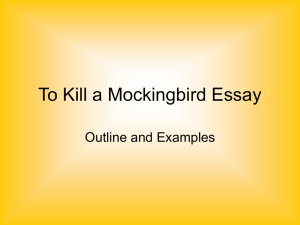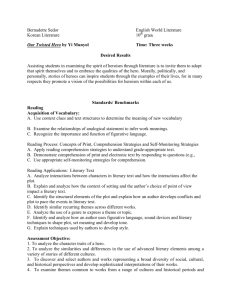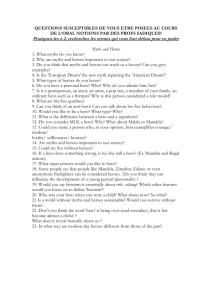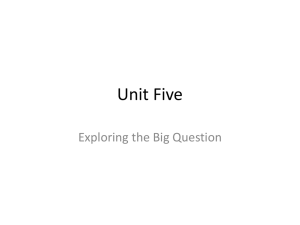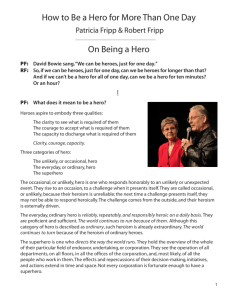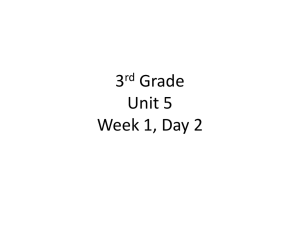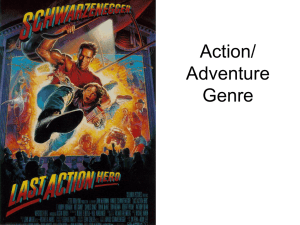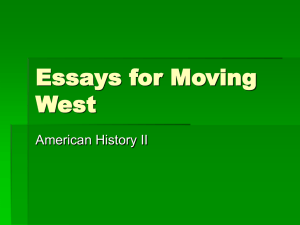Treasures Unit One Big Question
advertisement
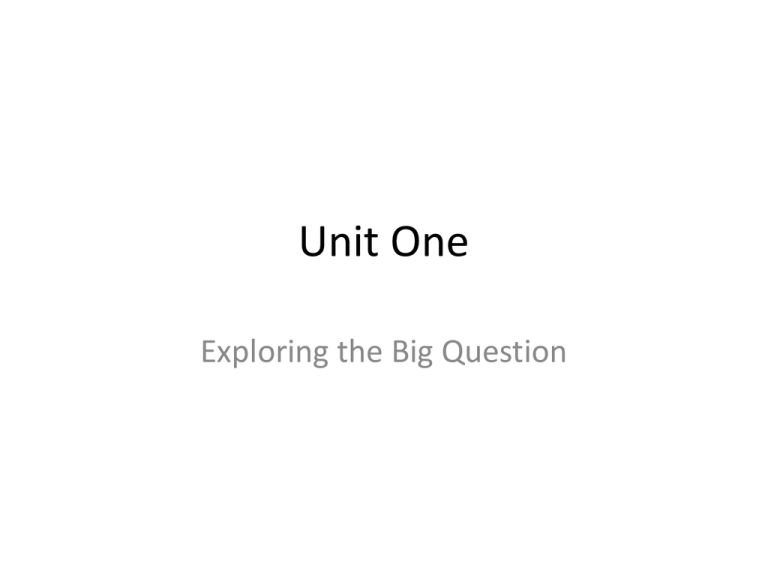
Unit One Exploring the Big Question Tiananmen Square Background “Everyone is necessarily the hero of his own life story.” ~ John Barth “…the key to heroism is a concern for other people in need—a concern to defend a moral cause, knowing there is a personal risk, done without expectation of reward.” ~ Philip Zimbardo, Ph.D. What are the characteristics of a hero? What makes a hero? Quotes for Small Group Facilitated Discussions “Nothing is given to man on earth – struggle is built into the nature of life, and conflict is possible – the hero is the man who lets no obstacle prevent him from pursuing the values he has chosen.” ~ Andrew Bernstein “You must be the change you want to see in the world.” ~ Mahatma Gandhi “The ultimate measure of a man is not where he stands in moments of comfort and convenience, but where he stands at times of challenge and controversy.” ~ Martin Luther King, Jr. “Our lives begin to end the day we become silent about things that matter.” ~Martin Luther King, Jr. “True heroism is remarkably sober, very undramatic. It is not the urge to surpass all others at whatever cost, but the urge to serve others at whatever cost.” ~Arthur Ashe “The world is a dangerous place, not because of those who do bad things, but because of those who look on and do nothing.” ~ Albert Einstein “…most heroes are ordinary people; it’s the act that’s extraordinary.” ~ Philip Zimbardo, Ph.D. “Every reasonable man and woman is a potential scoundrel and a potential good citizen. What a man is depends upon his character, what’s inside. What he does and what we think of what he does depends upon his circumstances.” ~ George Bernard Shaw Who are your heroes? Why? A Further Exploration of What Makes a Hero As a class, we will read, analyze, and discuss the following pieces in the reading textbook: “The Scribe” by Kristin Hunter on p. 10 “What Exactly Is a Hero?” by T. A. Barron on p. 46 Peruse the following stories in your reading textbook, and choose three selections you would be interested in reading and discussing in class: “The Fly” by Mai Vo-Dinh on p. 2 “Time Hurricane Heroes” by Thomas Fields-Meyer, Steve Helling, and Lori Rozsa on p. 24 “The Dog of Pompeii” by Louis Untermeyer on p. 28 “The King of Mazy May” by Jack London on p. 52 “All Stories Are Anansi’s” by Harold Courlander on p. 74 “Dragon, Dragon” by John Gardner on p. 81 “Three Queens of Egypt” by Vicki León on p. 95 “Street Magic” by Will Eisner on p. 102 “Stray” by Cynthia Rylant on p. 113 “Pecos Bill” by Mary Pope Osborne on p. 122 As you read, you will be thinking about aspects of heroism depicted in the story. An In-Depth Look at Heroism The Watson’s Go to Birmingham-1963 by Christopher Paul Curtis Wesley Autrey: An Everyday Hero Jessica Jackley: An Everyday Hero Meet More Everyday Heroes Comparing and Contrasting: Heroes and Authors’ Techniques The Courage That My Mother Had Edna St. Vincent Millay The courage that my mother had Went with her, and is with her still: Rock from New England quarried; Now granite in a granite hill. The golden brooch my mother wore She left behind for me to wear; I have no thing I treasure more: Yet, it is something I could spare. Oh, if instead she’d left to me The thing she took into the grave! – That courage like a rock, which she Has no more need of, and I have. My Father Is a Simple Man Luis Omar Salinas I walk to town with my father to buy a newspaper. He walks slower than I do so I must slow up. The street is filled with children. We argue about the price of pomegranates, I convince him it is the fruit of scholars. He has taken me on this journey and it's been lifelong. He's sure I'll be healthy so long as I eat more oranges, and tells me the orange has seeds and so is perpetual; and we too will come back like the orange trees. I ask him what he thinks about death and he says he will gladly face it when it comes but won't jump out in front of a car. I'd gladly give my life for this man with a sixth grade education, whose kindness and patience are true . . . The truth of it is, he's the scholar, and when the bitter-hard reality comes at me like a punishing evil stranger, I can always remember that here was a man who was a worker and provider, who learned the simple facts in life and lived by them, who held no pretense. And when he leaves without benefit of fanfare or applause I shall have learned what little there is about greatness. Assessments: Words of Week weekly vocabulary test Watson’s Go to Birmingham comprehension tests Accelerated Reader reading, vocabulary, and literary analysis test Treasures Unit 1 Assessment on pp. 150-154 Discussion of one everyday hero and reflections on heroism and the implications for one’s own life Optional if needed: Treasures individual story assessments and Treasures formative assessments to define differentiation Standards Embedded: 1.0 Word Analysis, Fluency , and Systematic Vocabulary Development Students use their knowledge of word origins and word relationships, as well as historical and literary context clues, to determine the meaning of specialized vocabulary and to understand the precise meaning of grade-level-appropriate words. Word Recognition 1.1 Read aloud narrative and expository text fluently and accurately and with appropriate pacing, intonation, and expression. Vocabulary and Concept Development 1.2 Identify and interpret figurative language and words with multiple meanings. 1.3 Recognize the origins and meanings of frequently used foreign words in English and use these words accurately in speaking and writing. 1.4 Monitor expository text for unknown words or words with novel meanings by using word, sentence, and paragraph clues to determine meaning. 1.5 Understand and explain “shades of meaning” in related words (e.g., softly and quietly). 2.0 Reading Comprehension (Focus on Informational Materials) Students read and understand grade-level-appropriate material. They describe and connect the essential ideas, arguments, and perspectives of the text by using their knowledge of text structure, organization, and purpose. In addition, by grade eight, students read one million words annually on their own. Structural Features of Informational Materials 2.1 Identify the structural features of popular media (e.g., newspapers, magazines, online information) and use the features to obtain information. 2.2 Analyze text that uses the compare-and-contrast organizational pattern. Comprehension and Analysis of Grade-Level-Appropriate Text 2.3 Connect and clarify main ideas by identifying their relationships to other sources and related topics. 2.4 Clarify an understanding of texts by creating outlines, logical notes, summaries, or reports. 2.5 Follow multiple-step instructions for preparing applications (e.g., for a public library card, bank savings account, sports club, league membership). Expository Critique 2.7 Make reasonable assertions about a text through accurate, supporting citations. 3.0 Literary Response and Analysis Students read and respond to historically or culturally significant works of literature that reflect and enhance their studies of history and social science. They clarify the ideas and connect them to other literary works. Structural Features of Literature 3.1 Identify the forms of fiction and describe the major characteristics of each form. Narrative Analysis of Grade-Level-Appropriate Text 3.2 Analyze the effect of the qualities of the character (e.g., courage or cowardice, ambition or laziness) on the plot and the resolution of the conflict. 3.3 Analyze the influence of setting on the problem and its resolution. 3.5 Identify the speaker and recognize the difference between first- and thirdperson narration (e.g., autobiography compared with biography). 3.6 Identify and analyze features of themes conveyed through characters, actions, and images. 3.7 Explain the effects of common literary devices (e.g., symbolism, imagery, metaphor) in a variety of fictional and nonfictional texts. Additional Standard Embedded in Poem of the Day: 3.4 Define how tone or meaning is conveyed in poetry through word choice, figurative language, sentence structure, line length, punctuation, rhythm, repetition, and rhyme. Expository Critique 2.7 Make reasonable assertions about a text through accurate, supporting citations. Additional Standard Embedded in novel study of The Watson’s Go to Birmingham: Literary Criticism 3.8 Critique the credibility of characterization and the degree to which a plot is contrived or realistic (e.g., compare use of fact and fantasy in historical fiction). Reading Standards Not Addressed in the Unit: Expository Critique 2.6 Determine the adequacy and appropriateness of the evidence for an author’s conclusions. 2.8 Note instances of unsupported inferences, fallacious reasoning, persuasion, and propaganda in text.
